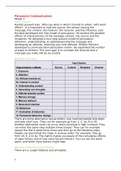Persuasive Communication
Week 1
Micro lecture
Harold Lasswell asks, ‘Who say what in which channel to whom, with what
effect?’ It is important to look the source, the person issuing the
message, the content, the medium, the receiver, and the influence. Carl
Hovland developed the Yale model of persuasion. He studied the possible
effects of characteristics of the message content, the source and the
recipients. He designed a four-step process model of persuasion.
Attention, understanding, accepting/rejecting the message and
developing an attitude, retaining your new attitude. William McGuire
developed a communication-persuasion matrix. He expanded the number
of steps to thirteen. The main goal is to increase the chances that a
message you make will be successful.
McGuire overview
There are some alternative causal orders. Low involved people skip steps
and take short cuts. They can for example go from 1, 2, 3a, 6 to 10.
Another alternative route can occur when someone is high involved. They
can enter the same step multiple times (loops). They can for example
repeat the first 6 steps three times and then go to the following steps.
People can also follow the steps in reverse order. For example, they go
from 10, 6, 2 to 3a. The matrix makes you aware of the cumulative effects
of input factors and of how input factors interact. You can see the weak
spots, and which input factors might help.
McGuire Fallacies and principles
There are a couple fallacies and principles.
1
, Attenuated-effect fallacy: successful influencing each output step is
dependent on the success at the previous steps. Suppose at each
step you successfully influence 50% of the people who reach this
step. You must expect small effects. Only 1% or 2% of the
consumers will change their behavior due to the exposure to the
campaign.
Distant-measure fallacy: if your goal is to sell, you measure
additional sales that can be attributed to campaign exposure.
Neglected-mediator fallacy: an input element increasing one output
step but decreasing it at another step. The combined successive
effects on all factors count. Effect times effect gives the total effect.
Compensatory principle: the reverse of the neglected-mediator
fallacy. If an input element has a negative effect on a certain output
step, this be compensated by more positive effect on another step.
Golden mean principle: more is not always better. You must apply
input elements at an intermediate level.
Situational-weighting principle: the effect an input element can
have, is dependent on other input elements. The total
situation/context must be considered.
Week 2
Micro lecture attitudes
Attitude is the positive or negative evaluation of a behavior. If you would
like to influence how other people behave, you need to influence the
evaluation of the behavior that you would like them to perform. You
cannot directly observe an evaluation. You infer other people’s attitude
towards a behavior from how they behave, their verbal or non-verbal
responses. Behavior is also called conative response. Attitude can be
based on cognitive response (words) or affective responses (emotions), or
both. They can also be weak or strong, depending on whether you think
deeply or superficially about something.
Weak arguments, not based on good arguments, easily change.
Strong attitude, based on well thought-through arguments, thought
deeply about cognitive and affective consequences, more difficult to
change.
Dual-process models are:
Elaboration likelihood model (Petty & Cacioppo)
Heuristic-systematic model (Chaiken)
System 1 and 2 (Kahneman): System 1 refers to the intuitive and
automatic processing. System 2 refers to the analytical and
controlled processing and leads to a reasoned cognitive evaluation.
Micro lecture theory of planned behavior
The theory of planned behavior of Icek Ajzen states that attitude toward a
behavior is based on an expectancy-value analysis (probability) of the
consequences (behavioral beliefs) of this behavior. It is the total sum of
the expectancy-value of each consequence, that is the probability and
evaluation of each consequence, that determines your attitude towards a
behavior. The theory says attitude is not the only determinant of behavior.
2




